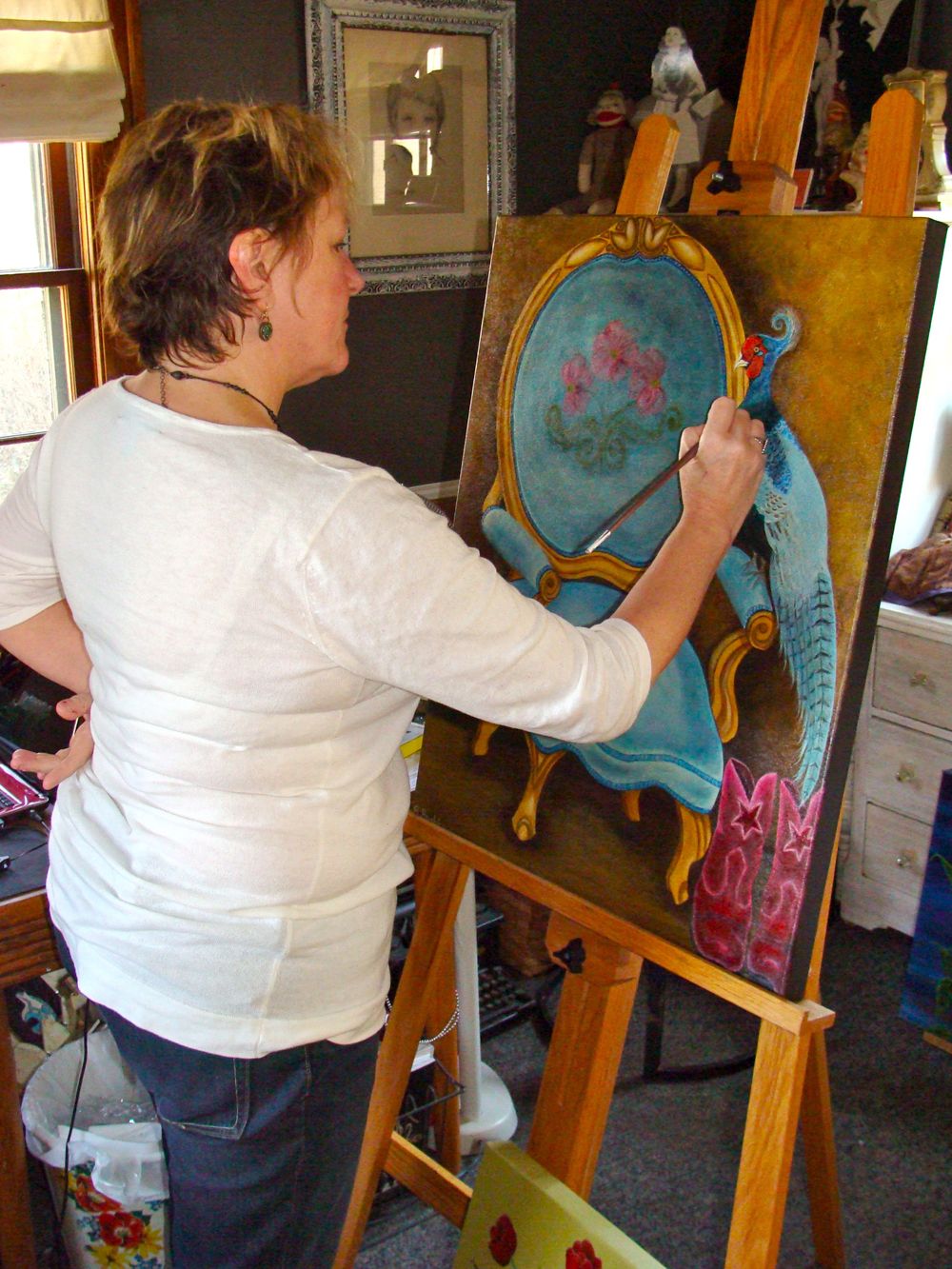Chatting with Beth Albright at her dining table on Fort Wayne’s south side, it is hard to keep focused on the artist, attractive and vibrant though she may be. One’s eyes tend to wander about her home’s pleasant interior, discovering one remarkable object after another: a colorful Tim Johnson painting, a mosaic urn, an antique wicker shopping cart. “I used to have an antique store,” she says, “and much of it is still here.” Vintage collectibles such as McCoy flower pots punctuate inviting rooms that manifest an artist’s eye for color and harmony. Sunshine pours through the windows, adding a sense of cheerful magic.
Albright is getting ready for her February show at the Orchard Gallery. It is her first gallery exhibit as a painter, having taken up acrylic painting just three years ago. Formerly, her main creative outlet was in textiles. She sewed and fashioned unique handmade hats and accessories, using luxurious fabrics and imaginative accent pieces, some of it painstakingly hand-stitched.
She has also dabbled in other media.
“Like this,” she says grabbing the mosaic urn from the coffee table and presenting it for closer inspection. Lifting the lid, she shows how she glued bits of glass, mirror, and broken pottery to the exterior of a sturdy ceramic pot and then grouted the spaces between them. Two glass drawer pulls oppose each other on the urn’s shoulders, creating the profile of a loving cup. Mounted on a brass Victorian-style lamp base, the urn has now come into its own and looks like an expensive piece from an art gallery.
“I used a dental pick to clean off every bit of grout,” she adds, revealing the attention to detail of a true craftsman.
Originally from Detroit, this former pharmacy technician says she has always been creative to the point of distraction. One has only to look about her house to see evidence of plenty of energy and devotion to making things, as well as a natural eye for color and composition.
And now Albright has turned her considerable creative drive to acrylic painting on canvas.
She is wholly self-taught, without formal training in art or art history, so when the comment is made that her still life paintings suggest another self-taught artist,19th century French painter Henri Rousseau, she is stumped and demands, “Who?”
Yet, amazingly, Albright has arrived at a very similar style all on her own. She shares with Rousseau a tendency to delineate objects and flatten space. Images feel frozen, still and timeless. Bold textile patterns are worked into the composition, synthesizing her love of fabrics into her new art form. Although the work is done in acrylics, Albright then likes to tone the finished painting with a glaze of linseed oil.
Houseplants are a favorite subject matter, and great care is taken to be botanically accurate. But this is not a tedious accuracy. Whether belonging to a cyclamen, orchid or sanseviera, each leaf and blossom appear lovingly rendered with familiarity and appreciation.
In fact, such careful deliberation compels the viewer to pause and consider the possibility of a deeper meaning or possible symbolism.
This phenomenon is often evoked by naive or folk painting. We get a sense that these pictures mean something, that here is an individual whose soul burns with a vision that must get out. Recall the motion picture Close Encounters of the Third Kind in which the character of the artist, the mother of the young boy abducted by a spaceship, is inexplicably driven to paint a vision of Devil’s Tower over and over. She knows it “means something.” The mountain, she eventually realizes, is a message from the abducting aliens, an invitation to retrieve her son at that location.
Some individuals are more sensitive to visual cues than others. When pressed as to what she is trying to get across in her paintings, Albright says she is just painting things from her childhood and past. She attributes the recurring motif of houseplants to having grown up with parents and grandparents who loved gardening and flowers. Knowing this, it is easy to see how, in her deeply personal and contemplative paintings, Beth Albright has found a way to revisit her own loved ones.
 Submit Your Event
Submit Your Event
